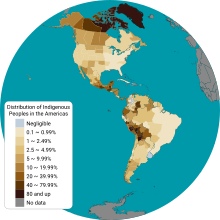
Indigenous peoples of the Americas
From Wikipedia, the free encyclopedia
The Indigenous peoples of the Americas are the inhabitants of the Americas before European colonization in the 15th century, and the ethnic groups who now identify themselves with those peoples. They are a diverse group of peoples, with a wide range of cultures, languages, and ways of life.
Some Indigenous peoples in the Americas have historically been hunter-gatherers, while others traditionally practice agriculture and aquaculture. In the Amazon basin in present-day South America, some Indigenous peoples still live as hunter-gatherers while those in other regions may maintain their traditional lifestyles to a lesser extent.[32]
Some Indigenous peoples have traditionally depended heavily on agriculture, and others on a mix of farming, hunting, and gathering. In some regions, Indigenous peoples have created pre-contact monumental architecture, large-scale organized cities, city-states, chiefdoms, states, kingdoms, republics,[33] confederacies, and empires. These societies have had varying degrees of knowledge of engineering, architecture, mathematics, astronomy, writing, physics, medicine, planting and irrigation, geology, mining, metallurgy, sculpture, and gold smithing.
Many parts of the Americas are still populated by Indigenous peoples; some countries have sizeable populations, especially Bolivia, Canada, Chile, Ecuador, Guatemala, Mexico, Peru, and the United States. At least a thousand different Indigenous languages are spoken in the Americas, where there are also 574 federally recognized tribes in the United States alone. Several of these languages are recognized as official by several governments such as those in Bolivia, Peru, Paraguay, and Greenland. Some, such as Quechua, Arawak, Aymara, Guaraní, Mayan, and Nahuatl, count their speakers in the millions. Whether contemporary Indigenous people live in rural communities or urban ones, many also maintain additional aspects of their cultural practices to varying degrees, including religion, social organization, and subsistence practices. Like most cultures, over time, cultures specific to many Indigenous peoples have also evolved, preserving traditional customs but also adjusting to meet modern needs. Some Indigenous peoples still live in relative isolation from Western culture and a few are still counted as uncontacted peoples.
